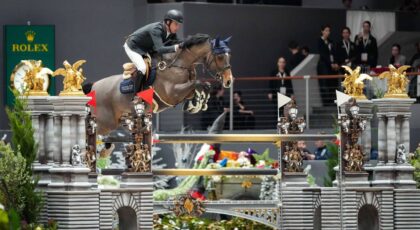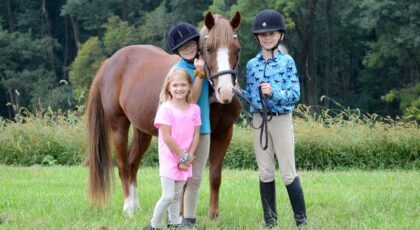My mom and I drove by our old place in Langley the other week and she asked me, ‘Tiffany, when we were living in that house, would you ever have thought that one day you would come back here and be the highest ranked female rider in the world?’
And the reality is no.
I didn’t really think that far ahead. Especially at the beginning of my career.
I mean, I rode hunters and equitation horses until I was 21. So highest ranked female international rider in the world? That wasn’t exactly on my radar.
But I definitely never had a ceiling on my ambition. I never thought it wasn’t possible—even when it probably didn’t seem possible.
Like in 2008 when I broke my back schooling a green horse through a cavaletti grid. A few months after, I was sitting in the stands at the Beijing Olympics with my back brace on, screaming my head off with all the Canadian fans as Canada won team silver and Eric Lamaze won the individual gold.
I told our good friend Kim Kirton then and there, ‘I’m going to ride at the next Olympics.’
At that point, I had never jumped a 1.40m class, I had a broken back and I wasn’t even riding. She just looked at me and kind of laughed. Like, sure.
But four years later I was on that team.
I went to my first Olympic Games in 2012. I went again in 2016 and for the third time this year for Paris 2024.
***
If you look at my career, I shouldn’t even be here.
My first horse was a riding school pony we couldn’t really afford. My mom booked me jobs doing commercials for kids toys, like Polly Pocket and Pound Puppies, and that’s how we paid for lessons and board.
By the time I was 13, I was working off my lessons in the barn. I spent all my free time there. I was a total barn rat.
After my chores, I would be waiting for my mom to pick me up and I would pour through old VHS tapes that Laura Balisky, my trainer, had in the office. I just watched them over and over and over again.
As a working student, I got to ride a lot of different horses and compete at all the equitation finals. But most of the time you’re working in the barn and it’s a grind—you’re grooming horses, you’re mucking stalls. When you dream of being a rider, it can feel like you’re a long way from where you want to be. There were definitely moments when I felt pretty discouraged.
But if I could go back, I’d tell myself to embrace this time. Absorb it all in. This is all actually going to come in handy at some point. Every little thing that you learn from every horse is something you put in your toolbox that’s going to help you with another horse down the road.
I learned so much about horsemanship then that I draw on almost every day now. If I had come from a different background, I probably wouldn’t have all of that knowledge.




***
When I first made the Canadian team, Jill Henselwood was a big part of the squad. I thought it was so cool how all the guys relied on her, how they believed she could do it. You could feel it.
As a team rider, that’s who you want to be. Somebody that the other riders can depend on. And I think, or hope, that I am.
But if there’s a legacy or something that I leave behind, I hope to be remembered for loving the horses.
For me, the most important thing is that the horses come first. They must, or what’s the point? My philosophy is that whatever is going wrong is my fault, and I just have to find a better way of communicating to my horse.
I always say that training a horse and learning what they like is like learning a new language. Sometimes you’ll get on a horse, and you are both speaking English and away you go.
And some you get on, and you won’t be speaking the same language. And it’s up to you to figure out how to communicate with them and help them understand exactly what it is that you want them to do in a way that is positive and kind and patient. Because for the most part, horses want to cooperate. It’s up to you to figure out how to communicate the message to your horse.
And if you can’t, maybe that’s not the horse for you.
That’s one lesson I learned as I went: it’s okay that you can’t ride every single horse.
Growing up as a catch rider, I’ve ridden many different horses throughout my career. As I get older, I’ve learned to stick with what works and you’re going to have more success because you’ve also got a data bank to draw from for that type of horse. You don’t have to learn a whole other language.
For me, I like a more sensitive horse. I struggle with one that’s really strong. I don’t like it when a horse pulls down. I mean, look at my arms. I can’t hold a big horse! Come on.
I like a high balance and a lot of blood. I want to whisper to the horse and have it happen.
Christos taught me that.
He was a lovely horse, a stallion. He had a very expressive jump and he landed with his head quite low. I still have pain sometimes after my back injury. I would get home at night after riding him and have to ice my back. And I’m like, “Why does it only hurt on the days that I ride Christos?” I realized that, Oh, it’s because the way he lands is jarring on my back. He’s a great horse, but he’s not a great horse for me.
I sent him to my good friend, Darragh Kenny, and he went on and won a bunch of stuff. So that was better for the horse. He had a better career because I wasn’t riding him. Not because I’m not a good rider. It wasn’t a perfect match.
That’s what’s awesome about this sport. The horse is the great equalizer.
***
The more you do this sport the more you realize how hard it is.
I think the thing that keeps me going now is that there is so much longevity in this sport. If you look at the average age of the top 10 riders in the world now, it’s something like 43 or 45 years old. It takes that long.
And you are always going to be a student. You are never going to be at a point where you think, okay, I know it all. Nothing more to learn. That will never happen.
For me, it’s really motivating to know that I am still on the way up. I haven’t peaked yet. And I started late, so maybe I’ll peak a little later. I want to see how far I can get so that I can look back and say that I got to accomplish a lot of things, and I had a good time.
And that I did it with integrity.
Whether you are dealing with your students, or your clients, or your horses, I think it is important to be honest. Sometimes you have to give bad news. I always say, I give the people around me all the information, and I know that they are intelligent enough to make their own decisions. I try never to kind of sugar coat things or not tell them things.
To me, healthy sport means doing things with integrity on every front.
Whatever you’re doing, do you feel good about it? Would you still be doing the same thing if your customers or your students were watching? I think that is important and I think that’s something people in our industry could probably do a little bit better.
But that is what I try to do in my life. And win a medal, of course.
Related reading:
- Erynn Ballard: 10 Years Ago I Was Known as a Hunter Rider
- Amy Millar: There Aren’t Many Moms in the Grand Prix
#WeRideTogether is proud to celebrate women in sport and promote healthy sport for all. Learn more at weridetogether.today.




 August 27, 2024
August 27, 2024 




























